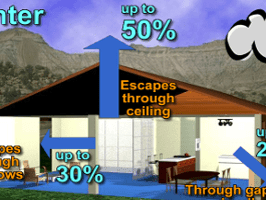To understand home insulation R-values, it helps to look at air flow first. Heat flows from warmer to cooler until there is no longer a temperature difference. In your home, this means that in winter heat flows directly from heated living spaces to nearby unheated areas, such as your home’s attic, and even to the outdoors. Heat flow can also move indirectly through interior ceilings, walls, and floors – wherever there is a difference in temperature. During summer, heat flows from the outdoors and attic to the interior of the house.
To maintain comfort, the heat lost in the winter must be replaced by your heating system and the heat gained in the summer must be removed by your cooling system. Properly insulating your home will decrease this heat flow by providing an effective resistance to the flow of heat.
Home Insulation R-Values
The effectiveness of home insulation is measured by the R-value. The higher the value, the better the insulation. The R-value is a measure of the insulation’s resistance to heat flow, also known as thermal resistance. The higher this value is, the better the resistance to heat transfer and therefore the greater your energy savings.
The R-value depends on the type of insulation, its density and thickness. The R-value of some insulations also depends on temperature, aging, and moisture build-up. Installing more insulation in your home increases the R-value and the resistance to heat flow.
The effectiveness of an insulation material’s resistance to heat flow also depends on how and where the insulation is installed. The overall R-value of a ceiling will be somewhat different from the R-value of the insulation itself because heat flows more readily through studs, joists, and other building materials, in a phenomenon known as thermal bridging. In addition, insulation that fills building cavities densely enough to reduce airflow can also reduce convective heat loss.
Cellulose ceiling insulation provides a much better performance value than fibreglass insulation, especially when it comes to reducing your electricity bills. Air tightness levels can be increased by as much as 30% by choosing cellulose over its counterpart.
Cellulose insulation is very good at fitting around items in your ceiling like ducts and electrical wiring, leaving virtually no air pockets that can reduce the overall efficiency of the ceiling insulation. Dense pack cellulose can seal the ceiling from air infiltration while providing the density to limit convection, when installed properly.
A holistic approach to home insulation
In order to get the most benefit from insulation it is important that a holistic approach is taken to address heat gain through windows, skylights and other permeations. Shutters, and internal fixtures such as blinds or curtains can be used to reduce heat gain and loss, in combination with appropriate and thorough roof insulation.
If you need any assistance, Cool or Cosy’s insulation specialists are here to help. You can even schedule a free insulation inspection today. Click here to learn more about our Cellulose roof insulation that is made right here in Adelaide.

